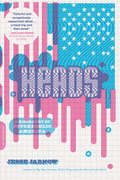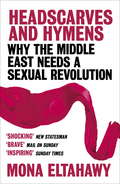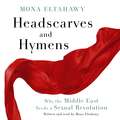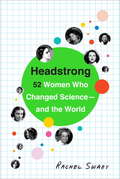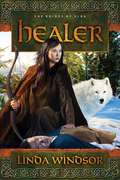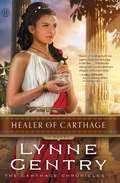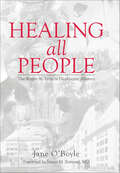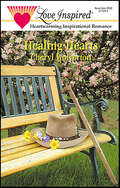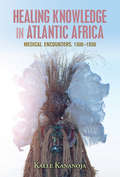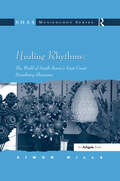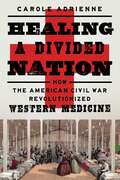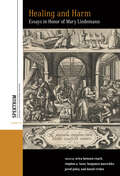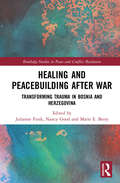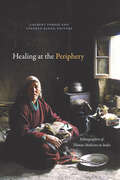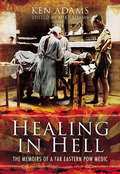- Table View
- List View
Heads Up Philosophy (DK Heads UP)
by DKThe second installment in DK's new Heads Up series, Heads Up Philosophy addresses the issues and theories that are most intriguing and relevant to the curious minds of teens — making a difficult topic easier to comprehend. Questions such as "What is knowledge?" "What is reality?" "What is the mind?" and "What's right and wrong?" are all addressed, offering big ideas, simply explained. Written and designed specifically for the teen market, Heads Up Philosophy combines challenging but clear text with cool graphic illustrations that clarify and explain theories and arguments. Biography spreads cover the famous quotes of great philosophers including Socrates, Aristotle, Friedrich Nietzsche, Epicurus, Plato, and Thomas Aquinas, while major theories and debates including epistemology, metaphysics, and ideologies are also explained. Heads Up Philosophy also includes case study panels, diagrams, and real world spreads to show how philosophical theories relate to everyday life. Making a difficult subject more approachable, Heads Up Philosophy is designed to provoke, entertain, and stimulate young minds.
Heads of the Local State: Mayors, Provosts and Burgomasters since 1800 (Historical Urban Studies)
by John GarrardIn recent decades there has been increasing historical interest in various aspects of local urban politics, resulting in a much better understanding of the recruitment and socio-economic characteristics of municipal leadership and the exercise of power at a local level. However, much less is known about the highly important offices and office-holders standing at the ceremonial, political and executive head of towns and cities. Through a comparative analysis of mayoralty since1800, this volume explores the characteristics of the office in relation to such issues as the constitutional position of mayors, their ceremonial and executive roles, their representational status in relation to local, regional and central authority, and their public visibility, which at various times has been used to highlight or blur issues of race, gender, politics or religion within a community. Drawing on examples from contrasting national contexts in Eastern and Western Europe, and North America, and with contributions from both historians and political scientists, this book will be welcomed as an important step in providing a much fuller international picture of the development and nature of urban governance.
Heads: A Biography of Psychedelic America
by Jesse JarnowHeads: A Biography of Psychedelic America uncovers a hidden history of the biggest psychedelic distribution and belief system the world has ever known. Through a collection of fast-paced interlocking narratives, it animates the tale of an alternate America and its wide-eyed citizens: the LSD-slinging graffiti writers of Central Park, the Dead-loving AI scientists of Stanford, utopian Whole Earth homesteaders, black market chemists, government-wanted Anonymous hackers, rogue explorers, East Village bluegrass pickers, spiritual seekers, Internet pioneers, entrepreneurs, pranksters, pioneering DJs, and a nation of Deadheads.WFMU DJ and veteran music writer Jesse Jarnow draws on extensive new firsthand accounts from many never-before-interviewed subjects and a wealth of deep archival research to create a comic-book-colored and panoramic American landscape, taking readers for a guided tour of the hippie highway filled with lit-up explorers, peak trips, big busts, and scenic vistas, from Vermont to the Pacific Northwest, from the old world head capitals of San Francisco and New York to the geodesic dome--dotted valleys of Colorado and New Mexico. And with the psychedelic research moving into the mainstream for the first time in decades, Heads also recounts the story of the quiet entheogenic revolution that for years has been brewing resiliently in the Dead's Technicolor shadow.Featuring over four dozen images, many never before seen--including pop artist Keith Haring's first publicly sold work--Heads weaves on of the 20th and 21st centuries' most misunderstood subcultures into the fabric of the nation's history. Written for anyone who wondered what happened to the heads after the Acid Tests, through the '70s, during the Drug War, and on to the psychedelic present, Heads collects the essential history of how LSD, Deadheads, tie-dye, and the occasional bad trip have become familiar features of the American experience.
Headscarves and Hymens: Why the Middle East Needs a Sexual Revolution
by Mona Eltahawy'Shocking, heartfelt and well-researched' New Statesman'A ground-shaping book that defines the edge of so many vital contemporary debates. Hers is a voice simultaneously behind and beyond the veil' Colum McCann'A fascinating, can't-look-away, whistle-stop tour of the Middle East' Daily Telegraph'Brave and impassioned . . . A shocking book, and one that will make anyone who has seen veiling as a cultural issue think very hard about what is really going on' Mail on SundayHeadscarves and Hymens explodes the myth that we should stand back and watch while women are disempowered and abused in the name of religion. In this laceratingly honest account, Eltahawy takes aim both at attitudes in the Middle East and at the western liberals who mistake misogyny for cultural difference. Her argument is clear: unless political revolution in the Arab world is accompanied by social and sexual revolution, no progress will be made.Headscarves and Hymens is the book the world has been crying out for: a powerful, fearless account of what it really means to be a woman in the Muslim world. 'A fascinating, can't-look-away, whistle-stop tour of the Middle East' Daily Telegraph'Brave and impassioned . . . A shocking book, and one that will make anyone who has seen veiling as a cultural issue think very hard about what is really going on' Mail on Sunday
Headscarves and Hymens: Why the Middle East Needs a Sexual Revolution
by Mona EltahawyWritten and read by the author.In November 2011, Mona Eltahawy came to worldwide attention when she was assaulted by police during the Egyptian Revolution. She responded by writing a groundbreaking piece in FOREIGN POLICY entitled 'Why Do They Hate Us?'; 'They' being Muslim men, 'Us' being women. It sparked huge controversy. In HEADSCARVES AND HYMENS, Eltahawy takes her argument further. Drawing on her years as a campaigner and commentator on women's issues in the Middle East, she explains that since the Arab Spring began, women in the Arab world have had two revolutions to undertake: one fought with men against oppressive regimes, and another fought against an entire political and economic system that treats women as second-class citizens in countries from Yemen and Saudi Arabia to Egypt, Tunisia, and Libya.Eltahawy has travelled across the Middle East and North Africa, meeting with women and listening to their stories. Her book is a plea for outrage and action on their behalf, confronting the 'toxic mix of culture and religion that few seem willing or able to disentangle lest they blaspheme or offend.' A manifesto motivated by hope and fury in equal measure, HEADSCARVES AND HYMENS is as illuminating as it is incendiary.(p) 2015 Macmillan Audio
Headstrong: 52 Women Who Changed Science-and the World
by Rachel SwabyFifty-two inspiring and insightful profiles of history's brightest female scientists. In 2013, the New York Times published an obituary for Yvonne Brill. It began: "She made a mean beef stroganoff, followed her husband from job to job, and took eight years off from work to raise three children." It wasn't until the second paragraph that readers discovered why the Times had devoted several hundred words to her life: Brill was a brilliant rocket scientist who invented a propulsion system to keep communications satellites in orbit, and had recently been awarded the National Medal of Technology and Innovation. Among the questions the obituary--and consequent outcry--prompted were, Who are the role models for today's female scientists, and where can we find the stories that cast them in their true light? Headstrong delivers a powerful, global, and engaging response. Covering Nobel Prize winners and major innovators, as well as lesser-known but hugely significant scientists who influence our every day, Rachel Swaby's vibrant profiles span centuries of courageous thinkers and illustrate how each one's ideas developed, from their first moment of scientific engagement through the research and discovery for which they're best known. This fascinating tour reveals these 52 women at their best--while encouraging and inspiring a new generation of girls to put on their lab coats.From the Trade Paperback edition.
Headwaters Park: Fort Wayne's Lasting Legacy
by Geoff PaddockThe history of Fort Wayne is deeply rooted in its connection to the three rivers that converge at its center: the Maumee, St. Mary's, and St. Joseph Rivers. This abundance of waterways provided great access and trading opportunities for the Fort Wayne area. However, their meeting place, the point at which the St. Mary's and the St. Joseph join to form the headwaters of the Maumee, served as a frequent flood plain and constantly evolving landscape. While humans declined to set up permanent settlements on the Fort Wayne "thumb," it hosted many important events. From the flood of 1790 to the circus grounds of the 1850s, to the first night baseball game of 1883 to a depression area shantytown of the 1930s, the rich legacy of the Headwaters is a vital part of the fabric of Fort Wayne's history.Today, through the efforts of the Fort Wayne community and the Headwaters Flood Control and Park project, the area has been transformed into one of the most forward thinking city park projects in the country, providing a home for many area festivals and a beautiful addition to the downtown landscape of Fort Wayne.
Healer
by Linda WindsorSixth-century Scotland--in the time of Arthur.... "The Gowrys' seed shall divide your mighty house and bring a peace beyond the ken of your wicked soul." Her mother's dying prophecy to the chieftain Tarlach O'Byrne sentenced Brenna of Gowrys to twenty years of hiding. Twenty years of being hunted--by the O'Byrnes, who fear the prophecy, and by her kinsmen, who expect her to lead them against their oppressors. But Brenna is a trained and gifted healer, not a warrior queen. So she lives alone in the wilderness with only her pet wolf for company. When she rescues a man badly wounded from an ambush, she believes he may be the answer to her deep loneliness. Healing him comes as easy as loving him. But can their love overcome years of bitterness and greed...and bring peace and renewed faith to the shattered kingdom?
Healer of Carthage: A Novel (The Carthage Chronicles)
by Lynne GentryA twenty-first-century doctor. A third-century plague. A love out of time. First-year resident Dr. Lisbeth Hastings is too busy to take her father's bizarre summons seriously. But when a tragic mistake puts her career in jeopardy, answering her father's call seems her only hope of redeeming the devastating failure that her life has become. While exploring the haunting cave at her father's archaeological dig, Lisbeth falls through a hidden hole, awakening to find herself the object of a slave auction and the ruins of Roman Carthage inexplicably restored to a thriving metropolis. Is it possible that she's traveled back in time, and, if so, how can she find her way back home? Cyprian Thascius believes God called him to rescue the mysterious woman from the slave trader's cell. What he doesn't understand is why saving the church of his newfound faith requires him to love a woman whose peculiar ways could get him killed. But who is he to question God? As their different worlds collide, it sparks an intense attraction that unites Lisbeth and Cyprian in a battle against a deadly epidemic. Even as they confront persecution, uncover buried secrets, and ignite the beginnings of a medical revolution, Roman wrath threatens to separate them forever. Can they find their way to each other through all these obstacles? Or are the eighteen hundred years between them too far of a leap?
Healing All People: The Roper St. Francis Healthcare Alliance
by Jane O'BoyleThis is the story of two centuries-old hospitals, Roper and St. Francis. They were neighbors that supported one another, where generations of doctors treated patients from the Civil War era through the civil rights era. Then the 1980s and 1990s changed the landscape in healthcare. National healthcare conglomerates came courting in Charleston, and the two hospitals that once supported each other became rivals in a swirl of lawsuitsand distrust. Jane O�Boyle interviewed scores of doctors and hospital staff to unravel a tale that is a touchstone of twentieth century Lowcountry history. Filled with colorful personalities and anecdotes, as well as black-and-white photographs, Healing All People is the heartwarming and entertaining story of community members who went beyond the call to save a cherished tradition. Charleston doctors and staff at Roperand St. Francis revered their mission to serve the community over profits. In order to preserve this mission, a handful of these medical professionals and sisters sought out the solution that would permit them to resolve old conflicts and build the foundation for a state-of-the-art healthcare system. In addition to a fascinating history, this story is an entertaining snapshot of Charleston in the days after Hurricane Hugo and before the onslaught of the widespread development of the 1990s.
Healing Gotham: New York City’s Public Health Policies for the Twenty-First Century
by Bruce F. BergNew York City provides the ideal context for studying urban public health policy.Throughout its history, New York City has been challenged by a variety of public health crises. Since the nineteenth century—when it became one of the first American cities to develop a comprehensive public health infrastructure—New York has also stood at the forefront of formulating and implementing urban health policy. Healing Gotham examines in depth how the city has responded to five serious contemporary public health threats: childhood lead poisoning, childhood asthma, HIV/AIDS, obesity, and West Nile virus.Bruce F. Berg examines the rise and incidence of each condition in the city while explaining why the array of primary tools utilized by urban policy makers—including monitoring and surveillance, education, regulations, and the direct provision of services—have been successful in controlling public health problems. He also argues that forces such as race and ethnicity, New York City’s relationship to the state and federal government, the promotion of economic development, and the availability of knowledge related to preventing, treating, and managing illness all influence effective public health policy making.By contrasting these five particular cases, this exciting study allows scholars and students to compare public health policy through time and across type. It also helps policy makers understand how best to develop and implement effective public health strategies around the United States.
Healing Hearts
by Cheryl WolvertonFun-loving schoolteacher Tessa Stanridge needed a way to stay in Hill Creek-fast! Suddenly, like a gift from God, a white knight in the form of accident victim Drake Slater came to her rescue. The moment she saw the handsome rancher, she knew he was a man desperately in need of her loving care-just as she knew her life would never be the same.Drake was out to prove he was every bit the same rugged loner he had been before his accident. Trouble was, with Tessa around, even that wouldn't be enough. Now, it wasn't just that he wanted to learn to walk again-Tessa was the kind of woman who made a man want to be better than he was. And for this man, Tessa was turning out to be the best medicine of all.
Healing Histories: Stories from Canada's Indian Hospitals
by Laurie Meijer DreesA social history of tubercular hospitals and Canada’s indigenous population, built around “poignant and at times heartbreaking” firsthand accounts (Choice). Featuring oral accounts from patients, families, and workers who experienced Canada’s Indian Hospital system, Healing Histories presents a fresh perspective on health care history that includes the diverse voices and insights of the many people affected by tuberculosis and its treatment in the mid-twentieth century. This intercultural history models new methodologies and ethics for researching and writing about indigenous Canada based on indigenous understandings of “story” and its critical role in Aboriginal historicity, while moving beyond routine colonial interpretations of victimization, oppression, and cultural destruction. Written for both academic and popular reading audiences, Healing Histories, the first detailed collection of Aboriginal perspectives on the history of tuberculosis in Canada’s indigenous communities and on the federal government’s Indian Health Services, is essential reading for those interested in Canadian Aboriginal history, the history of medicine and nursing, and oral history.
Healing Knowledge in Atlantic Africa: Medical Encounters, 1500–1850 (Global Health Histories)
by Kalle KananojaIn this ambitious analysis of medical encounters in Central and West Africa during the era of the Atlantic slave trade, Kalle Kananoja focuses on African and European perceptions of health, disease and healing. Arguing that the period was characterised by continuous knowledge exchange, he shows that indigenous natural medicine was used by locals and non-Africans alike. The mobility and circulation of healing techniques and materials was an important feature of the early modern Black Atlantic world. African healing specialists not only crossed the Atlantic to the Americas, but also moved within and between African regions to offer their services. At times, patients, Europeans included, travelled relatively long distances in Africa to receive treatment. Highlighting cross-cultural medical exchanges, Kananoja shows that local African knowledge was central to shaping responses to illness, providing a fresh, global perspective on African medicine and vernacular science in the early modern world.
Healing Meditations
by Swami ParamanandaFirst published in 1932, this little book from Swami Paramananda, the highly-regarded Vedanta philosopher and teacher, contains nine guided meditations—one each for the individual to address life’s problems and issues.“THERE is nothing so potent as meditation to re-establish our rhythm when our mind is tossed by the waves of unruly thought.“There is no ill in life that cannot be cured by right meditation.“True meditation purifies our mind and clarifies our vision.“True meditation gives us, as it were, wings for flight to a higher realm and thus detaches us from terrestrial fetters.“It is through the habit of meditation we overcome all our sorrows and afflictions. “For every ill there is a meditation. There is the Meditation of Life, Meditation of Light, Meditation of Purity, Meditation of Humility, Meditation of Joy, Meditation of Freedom, Meditation of Love, Meditation of Wisdom, Meditation of Peace.”—Swami Paramananda
Healing Rays
by Sir George JeffreysHealing Rays by Sir George Jeffreys is a powerful and inspirational exploration of divine healing through faith, offering profound insights into the spiritual principles that underlie miraculous recoveries and the transformative power of prayer. Written by a prominent figure in the early Pentecostal movement, this book presents a compelling case for the reality of divine healing as a manifestation of God's love and power.Jeffreys, known for his dynamic ministry and healing campaigns, draws on his extensive experience and deep understanding of the Bible to articulate a clear and compelling theology of healing. He emphasizes the importance of faith, the authority of Scripture, and the role of the Holy Spirit in the healing process, providing readers with both the spiritual foundation and practical guidance needed to access the healing rays of God’s grace.Healing Rays is filled with testimonies of miraculous healings, each serving as a testament to the living power of faith and the effectiveness of prayer. Jeffreys shares stories of individuals who have experienced physical, emotional, and spiritual restoration, offering hope and encouragement to all who seek healing in their own lives or in the lives of others.The book also addresses common questions and doubts about divine healing, offering theological clarity and pastoral wisdom. Jeffreys discusses the relationship between faith and healing, the significance of the atonement in the healing ministry, and the ways in which believers can cultivate an atmosphere of faith and expectation for God’s healing work.Healing Rays is essential reading for anyone interested in the principles of divine healing, the power of faith, and the dynamic work of the Holy Spirit. Sir George Jeffreys’ passionate and faith-filled approach continues to inspire believers around the world, offering a powerful reminder that God’s healing rays are available to all who seek them with a sincere heart.This book remains a vital resource for those seeking to deepen their understanding of healing in the Christian faith and to experience the life-changing power of God’s healing touch.
Healing Rhythms: The World of South Korea's East Coast Hereditary Shamans (SOAS Studies in Music)
by Simon MillsStill today, in South Korea, many people pay for the services of mudang - the intermediaries of Korea's syncretic folk religion. The majority of mudang are called to the profession by gods; their clients are individuals or small groups and they focus on the use of spirit-power ('possession') for diagnosis and problem-solving. There is, however, a tiny minority of mudang who are born or adopted into the ritual life and who have no spirit-power. These ritualists perform in large family groups, conducting rituals for whole communities. They focus far more on the use of music, dance, and song to provide healing experiences. In this book, Simon Mills provides an in-depth analysis of the East Coast hereditary mudang institution and its rhythm-oriented music, focusing particularly on the Kim family of mudang - the government-appointed 'cultural assets' for the genre. It is the first English language book to study this tradition in any depth, using materials from fieldwork (1999-2000) alongside interviews with two key family members, Kim Junghee and Jo Jonghun. Throughout, Mills includes numerous quotes from the ritualists themselves to help reveal their characters, opinions and beliefs. He documents the family's history, the decline of the hereditary mudang institution and its kinship customs, and the family's changing relations towards 'outsiders'. Mills also details ritual procedures, musical structures, playing techniques, instruments, and learning methods both of the past and present; as non-ritual musicians become increasingly aware of the powerful ritual rhythms, the music is finding new life in non-ritual settings. A 5-track CD featuring Kim, Jo, and Mills accompanies the book, each track corresponding to the equivalent chapter in the text.
Healing Water: A Hawaiian Story
by Joyce Moyer HostetterWhen teenaged Pia is sent to Hawaii's leprosy settlement on Molokai Island in the 1860s, he chooses anger and self-reliance as his means of survival, but the faithful example of other villagers and one remarkable priest threaten to destroy his desire for revenge.This content is optimized for tablets.
Healing a Divided Nation: How the American Civil War Revolutionized Western Medicine
by Carole AdrienneA profound and insightful investigation into how the American Civil War transformed modern medicine.At the start of the Civil War, the medical field in America was rudimentary, unsanitary, and woefully underprepared to address what would become the bloodiest conflict on U.S. soil. However, in this historic moment of pivotal social and political change, medicine was also fast evolving to meet the needs of the time. Unprecedented strides were made in the science of medicine, and as women and African Americans were admitted into the field for the first time. The Civil War marked a revolution in healthcare as a whole, laying the foundations for the system we know today. In Healing a Divided Nation, Carole Adrienne will track this remarkable and bloody transformation in its cultural and historical context, illustrating how the advancements made in these four years reverberated throughout the western world for years to come. Analyzing the changes in education, society, humanitarianism, and technology in addition to the scientific strides of the period lends Healing a Divided Nation a uniquely wide lens to the topic, expanding the legacy of the developments made. The echoes of Civil War medicine are in every ambulance, every vaccination, every woman who holds a paying job, and in every Black university graduate. Those echoes are in every response of the International and American Red Cross and they are in the recommended international protocol for the treatment of prisoners of war and wounded soldiers. Beginning with the state of medicine at the outset of the war, when doctors did not even know about sterilizing their tools, Adrienne illuminates the transformation in American healthcare through primary source texts that document the lives and achievements of the individuals who pioneered these changes in medicine and society. The story that ensues is one of American innovation and resilience in the face of unparalleled violence, adding a new dimension to the legacy of the Civil War.
Healing and Harm: Essays in Honor of Mary Lindemann (Spektrum: Publications of the German Studies Association #29)
by Erica Heinsen-Roach, Stephen A. Lazer, Benjamin Marschke, Jared Poley, and Daniel RichesProfessor Mary Lindemann inspired several generations of historical researchers in early modern history and culture. She has served as president of the German Studies Association and the American Historical Association and is the author of pathbreaking scholarly work in the history of medicine, urban space, diplomacy, and of women. In honor of her scholarship, service, and dedication, Healing and Harm gathers a group of leading scholars that includes her students, contemporaries, and those who have been inspired by her work to continue Lindemann’s prolific arguments and observations on early modern, central European and German history and culture.
Healing and Peacebuilding after War: Transforming Trauma in Bosnia and Herzegovina (Routledge Studies in Peace and Conflict Resolution)
by Nancy Good Marie E. Berry Julianne FunkThis book brings together multiple perspectives to examine the strengths and limitations of efforts to promote healing and peacebuilding after war, focusing on the aftermath of the traumatic armed conflict in Bosnia and Herzegovina. This book begins with a simple premise: trauma that is not transformed is transferred. Drawing on multidisciplinary insights from academics, peace practitioners and trauma experts, this book examines the limitations of our current strategies for promoting healing and peacebuilding after war while offering inroads into best practices to prevent future violence through psychosocial trauma recovery and the healing of memories. The contributions create a conversation that allows readers to critically rethink the deeper roots and mechanisms of trauma created by the war. Collectively, the authors provide strategic recommendations to policymakers, peace practitioners, donors and international organizations engaged in work in Bosnia and Herzegovina – strategies that can be applied to other countries rebuilding after war. This volume will be of much interest to students of conflict resolution, peacebuilding, social psychology, Balkan politics and International Relations in general.
Healing at the Periphery: Ethnographies of Tibetan Medicine in India
by Laurent Pordié and Stephan Kloos, EditorsIndia has long occupied an important place in Tibetan medicine's history and development. However, Indian Himalayan practitioners of Tibetan medicine, or amchi, have largely remained overlooked at the Tibetan medical periphery, despite playing a central social and medical role in their communities. Power and legitimacy, religion and economic development, biomedical encounters and Indian geopolitics all intersect in the work and identities of contemporary Himalayan amchi. This volume examines the crucial moment of crisis and transformation that occurred in the early 2000s to offer insights into the beginnings of Tibetan medicine's professionalization, industrialization, and official recognition in India and elsewhere. Based on fine-grained ethnographic studies in Ladakh, Zangskar, Sikkim, and the Darjeeling Hills, Healing at the Periphery asks how the dynamics of capitalism, social change, and the encounter with biomedicine affect small communities on the fringes of modern India, and, conversely, what local transformations of Tibetan medicine tell us about contemporary society and health care in the Himalayas and the Tibetan world.Contributors. Florian Besch, Calum Blaikie, Sienna R. Craig, Barbara Gerke, Isabelle Guérin, Kim Gutschow, Pascale Hancart Petitet, Stephan Kloos, Fernanda Pirie, Laurent Pordié
Healing in Hell: The Memoirs of a Far Eastern POW Medic
by Ken AdamsKen Adams, as a trained medic, was sent out to the Far East and immediately saw action on the Malay Peninsula. Captured at Singapore he initially worked at Changi Hospital. Many moves and much worse capos in Thailand were to follow. He describes his life, work and the terrible conditions endured at the hands of the Japanese and Korea guards and worst of all, the Kempetai secret police.Illnesses such as dysentery, malaria, avitominosis, cholera and smallpox had to be treated with minimal or no medicines. Starvation was a fact of life.The author was frequently moved around and in 1945 took part in a march of many hundreds of miles which inevitably proved fatal to many of his fellow POWs.Liberation and repatriation are movingly described as, most significantly, is the whole process of settling back into normal life after so long in captivity of the worst kind.Healing in Hell is an exceptional account that demands reading.
Healing the Highlander (The Daughters of the Glen)
by Melissa MayhueAndrew MacAlister longs for a cure to free him from the excruciating pain caused by an old wound, but when he rescues a drowning woman, he has no idea how much his life is about to change. All Drew knows is that this mysterious woman is hiding secrets—and that he&’s never felt such a consuming desire before. Yet he cannot deny her request for help, even if it means bringing the detested English army to his Highland clan&’s home. Leah Noble McQuarrie still harbors a deep hatred of the Fae who tortured her eleven years ago, forcing her to escape back in time to the thirteenth century. A descendant of the Fae, Leah denies her heritage and her magical healing abilities. But the English army is holding her beloved adoptive grandfather captive, so Leah must seek help from the Fae—and the captivating man whose touch she craves. Then Drew discovers Leah&’s secrets, and he&’s torn between old loyalties and trusting a woman who has the power to give him the future he&’s sought—but could destroy his clan forever…
Healing the Soldier's Heart
by Lily GeorgeThe Soldier's Homecoming Ensign James Rowland was fortunate to return from Waterloo unscathed-at least in body. But guilt from that terrible battle has left him almost mute and crushed in spirit. Only in the company of sweet, compassionate Lucy Williams, a volunteer at the Veterans' Group in Bath, does he begin to feel happiness is within reach. Penniless governesses can't afford dreams of romance. Lucy Williams is resigned to lifelong spinsterhood-until James enters her life. His mother opposes the match. Lucy herself is sure the chasm between their ranks is too wide. But now that she has helped heal James, he intends to overcome every obstacle between them...and emerge victorious in the battle for her love.


